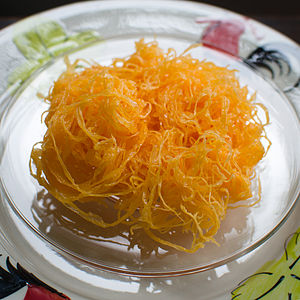Foi thong: Difference between revisions
(Created page with " <!-- seo --> {{#seo: |title=--title-- |titlemode=replace |description=--description-- |og:image=--og_image-- |og:type=article }} <!-- /seo --> Image:{{PAGENAME}}.jpg|300px|...") |
No edit summary |
||
| (2 intermediate revisions by the same user not shown) | |||
| Line 2: | Line 2: | ||
<!-- seo --> | <!-- seo --> | ||
{{#seo: | {{#seo: | ||
|title= | |title=Foi thong (Fois de ovos). A Thai dessert recipe | ||
|titlemode=replace | |titlemode=replace | ||
| | |keywords=#foithong #eggs #chicken #preparedfoods | ||
| | |hashtagrev=12032020 | ||
| | |description=Foi thong is a dessert made from egg yolks drawn into threads and boiled in sugar syrup | ||
}} | }} | ||
<!-- /seo --> | <!-- /seo --> | ||
[[Image:Foi thong.jpg|300px|thumb|right|Foi Thong (Thailand)]] | |||
'''Fios de ovos'''; ''Portugal'' ("egg threads"), '''Foi thong''';''Thailand'' (ฝอยทอง; "golden strands"), '''Angel hair'''; ''English'', is a traditional sweet food made of [[eggs]] (mainly yolks), drawn into thin strands and boiled in [[sugar]] syrup. They are a traditional element in Thai, Portuguese and Brazilian cuisine, both in desserts and as side dishes. | |||
The preparation is also known in Spain as huevo hilado ("spun egg"), in Japan as keiran somen (鶏卵素麺, "hen's egg noodle"), in Cambodia as vawee, in Malaysia as jala mas ("golden net"). | |||
====History==== | |||
Like other egg-based Portuguese sweets, fios de ovos is believed to have been created by Portuguese monks and nuns around the 14th or 15th centuries. Laundry was a common service performed by convents and monasteries, and their use of egg whites for "starching" clothes created a large surplus of yolks. The recipe was probably taken to Japan and Thailand by Portuguese explorers between the 16th and 18th centuries. | |||
[[ | ===Typical recipe=== | ||
[[ | =====Ingredients===== | ||
[[ | * Yolks from 10 duck's [[eggs]] and 5 [[Chicken|hen]]'s [[eggs]] | ||
[[Category: | * 3 cups of [[sugar]] | ||
* 2 cups of water scented with jasmine | |||
* 1 piece of thin white cloth for filtering | |||
=====Method===== | |||
# Put all the yolk on a piece of thin white cloth, fold it up, and squeeze the cloth to filter the yolk through it. | |||
# To make syrup, boil sugar in water scented with jasmine in a pot. When all the sugar dissolves, take the water to be filtered before continuing stewing it until bubbles appear all over the surface. | |||
# Pour the yolk through a narrow funnel which is placed over the pot of syrup so that the yolk will become golden threads in the syrup. | |||
# Use a long pointed piece of wood to stir the golden threads in the syrup until they become smooth. Then remove them from heat and wrap them around themselves so that they form the shape of a rectangle. | |||
====Information sources==== | |||
''Recipe'' | |||
* http://www.thaiwaysmagazine.com/thai_desserts/dessert_foi_thong.html | |||
''Article'' | |||
* http://en.wikipedia.org/wiki/Fios_de_ovos | |||
[[Category:Ingredients]] | |||
[[Category:Prepared foods]] | [[Category:Prepared foods]] | ||
{{CategoryLineIngredients}} | |||
<!-- footer hashtags --><code 'hashtagrev:12032020'>[[Special:Search/foithong|#foithong]] [[Special:Search/eggs|#eggs]] [[Special:Search/chicken|#chicken]] [[Special:Search/preparedfoods|#preparedfoods]] | |||
[[ | </code><!-- /footer hashtags --> | ||
[[ | |||
[[ | |||
[[ | |||
Latest revision as of 11:04, 5 February 2015

Fios de ovos; Portugal ("egg threads"), Foi thong;Thailand (ฝอยทอง; "golden strands"), Angel hair; English, is a traditional sweet food made of eggs (mainly yolks), drawn into thin strands and boiled in sugar syrup. They are a traditional element in Thai, Portuguese and Brazilian cuisine, both in desserts and as side dishes.
The preparation is also known in Spain as huevo hilado ("spun egg"), in Japan as keiran somen (鶏卵素麺, "hen's egg noodle"), in Cambodia as vawee, in Malaysia as jala mas ("golden net").
History
Like other egg-based Portuguese sweets, fios de ovos is believed to have been created by Portuguese monks and nuns around the 14th or 15th centuries. Laundry was a common service performed by convents and monasteries, and their use of egg whites for "starching" clothes created a large surplus of yolks. The recipe was probably taken to Japan and Thailand by Portuguese explorers between the 16th and 18th centuries.
Typical recipe
Ingredients
- Yolks from 10 duck's eggs and 5 hen's eggs
- 3 cups of sugar
- 2 cups of water scented with jasmine
- 1 piece of thin white cloth for filtering
Method
- Put all the yolk on a piece of thin white cloth, fold it up, and squeeze the cloth to filter the yolk through it.
- To make syrup, boil sugar in water scented with jasmine in a pot. When all the sugar dissolves, take the water to be filtered before continuing stewing it until bubbles appear all over the surface.
- Pour the yolk through a narrow funnel which is placed over the pot of syrup so that the yolk will become golden threads in the syrup.
- Use a long pointed piece of wood to stir the golden threads in the syrup until they become smooth. Then remove them from heat and wrap them around themselves so that they form the shape of a rectangle.
Information sources
Recipe
Article